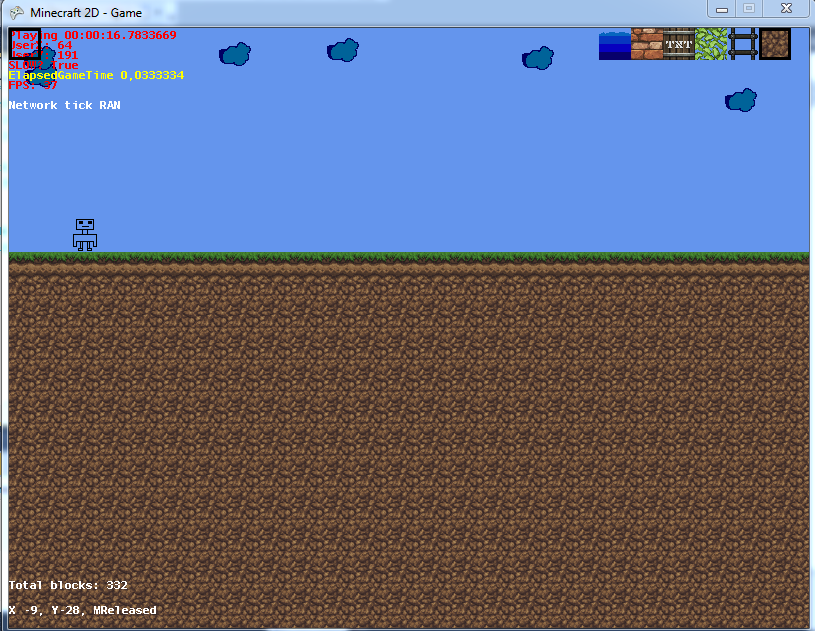I'm creating a game in XNA similar to Minecraft - Minecraft 2D
It looks like this

Here's how it works:
All blocks are generated once with fixed x,y coordinates and just re-drawn.
//generate world for (int i = 0; i < 25; i++) { blocks.Add(new Block("top", i * 32, 32 * 7, Color.White)); for (int j = 8; j < 20; j++) { blocks.Add(new Block("dirt", i * 32, 32 * j, Color.White)); } }When user clicks on a block, I just browse through all blocks and check whether block exists.
if ((mouseCoordinate.X - (mouseCoordinate.X % 32)) == block.x && (mouseCoordinate.Y - (mouseCoordinate.Y % 32)) == block.y) { //destroy block }Currently, without any camera movements, everything works. When I move my camera just about 32px to the right, for example, it's all broken. I can't do previous step anymore.
- What I need: I need to get mouse position relative to the map, not to the game window. How can I get mouse position relative to the map? Basically, I want mouse position 0,0 on the point I have circled here

How do I calculate it?
EDIT: here's my camera class (yes, Matrix)
using System;
using System.Collections.Generic;
using System.Linq;
using System.Text;
using Microsoft.Xna.Framework;
using Microsoft.Xna.Framework.Content;
using Microsoft.Xna.Framework.GamerServices;
using Microsoft.Xna.Framework.Graphics;
using Microsoft.Xna.Framework.Input;
using System.Reflection;
namespace MojePrvniHra
{
public class Camera2d
{
protected float _zoom; // Camera Zoom
public Matrix _transform; // Matrix Transform
public Vector2 _pos; // Camera Position
protected float _rotation; // Camera Rotation
public Camera2d()
{
_zoom = 1.0f;
_rotation = 0.0f;
_pos = Vector2.Zero;
}// Sets and gets zoom
public float Zoom
{
get { return _zoom; }
set { _zoom = value; if (_zoom < 0.1f) _zoom = 0.1f; } // Negative zoom will flip image
}
public float Rotation
{
get { return _rotation; }
set { _rotation = value; }
}
// Auxiliary function to move the camera
public void Move(Vector2 amount)
{
_pos += amount;
}
// Get set position
public Vector2 Pos
{
get { return _pos; }
set { _pos = value; }
}
public Matrix get_transformation(GraphicsDevice graphicsDevice)
{
_transform =
Matrix.CreateTranslation(new Vector3(-_pos.X, -_pos.Y, 0)) *
Matrix.CreateRotationZ(_rotation) *
Matrix.CreateScale(new Vector3(Zoom, Zoom, 1)) *
Matrix.CreateTranslation(new Vector3(graphicsDevice.Viewport.Width * 0.5f, graphicsDevice.Viewport.Height * 0.5f, 0));
return _transform;
}
}
}
and here's how I start my spriteBatch
spriteBatch.Begin(SpriteSortMode.BackToFront,
BlendState.AlphaBlend,
null,
null,
null,
null,
cam.get_transformation(graphics.GraphicsDevice));

foreach(Block b in blocks) { //if statement posted }. I'm not sure, how do I get "World position". I bet it's something trivial, but I'm unsure I know what it currently is. Do you mean mouse position on world? \$\endgroup\$int blockX = (int)(mouseWorld.X / tileWidth)and in the Y axis it would be:int blockY = (int)(mouseWorld.Y / tileHeight). \$\endgroup\$